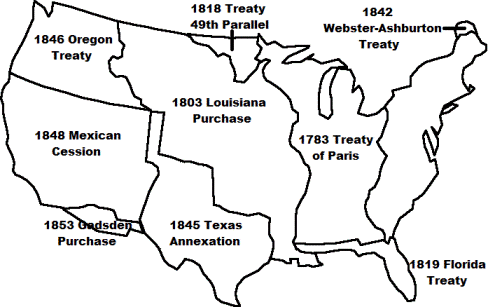|
Territorial Expansion Map

Territorial Expansion Map
|
Popular Sovereignty and the Slavery Debate
The Popular Sovereignty
and Slavery debate began in 1846 following the
Annexation of Texas
and the
Mexican-American War which had had highlighted the
issue of US Territorial Expansion and the question of
whether slavery should be permitted in new states. In
less than 100 years treaties had made by the United
States acquiring new land and extending US territory
from the Atlantic to the Pacific coast, as indicated on
the territorial expansion map.
Popular Sovereignty and the Slavery Doctrine
The Popular Sovereignty
and Slavery doctrine was first proposed in 1847 by Vice President
George Dallas as a political policy that would allow the
American settlers of new federal territories to decide
whether to enter the Union as free or slave states. The
idea was taken up by Lewis Cass in his 1848 presidential
campaign causing a split in the
Democratic party, which
led to many anti-slavery Democratic politicians to join
the
Free Soil
Party.
Popular Sovereignty and the Slavery Expansion Issue: The Compromise
of 1850
The Popular Sovereignty
and Slavery doctrine was then incorporated in the
Compromise of 1850
which had been drafted by Henry Clay and Democratic Senator Stephen
A. Douglas of Illinois. The Compromise of 1850 was an attempt to
defuse the 4 year confrontation between the free states of the North
and the slave states of the South regarding the status of
territories acquired during the Mexican-American War. The Compromise
of 1850 allowed California to be admitted as a free state and the
admission of New Mexico Territory and Utah Territory with slavery
was left to popular sovereignty.
Popular Sovereignty and the Slavery Issue for kids: The 1854 Kansas-Nebraska
Act
Popular Sovereignty
was an important feature of the
1854 Kansas-Nebraska Act which
was drafted by Stephen A. Douglas and created the territories of
Kansas and Nebraska and opened new lands for settlement. The
Kansas-Nebraska Act allowed white male settlers in Kansas and
Nebraska to decide, through popular sovereignty, whether they would
allow slavery within each territory. The Kansas-Nebraska Act
effectively repealed the
Missouri Compromise of 1820 that retained
the balance between slave and free states admitted to the Union. The
Kansas-Nebraska Act and the doctrine of Popular Sovereignty and
slavery divided the country and pointed the nation towards civil
war.
Popular Sovereignty and the Slavery Issue for kids: Bleeding Kansas
The Popular Sovereignty
and Slavery issue exploded with
critics of the doctrine calling
it "squatter sovereignty." Violence broke out between proslavery and
anti-slavery factions and reached a state of low intensity civil war
and this disastrous event became known
Bleeding Kansas.
Popular Sovereignty and Slavery Issue: The Republican Party is
formed
The
issue of Popular Sovereignty
and Slavery led to a turmoil in US politics. The Free Soil Party and
the
newly formed
National Union Party emerged as the new
Republican Party
in opposition to the Kansas-Nebraska Act. The goal of new Republican
Party, that was based in the north, was to stop the expansion of
slavery.
Popular Sovereignty
and Slavery for kids
The info about the Popular Sovereignty
and Slavery provides interesting facts and
important information about this important event that occured during the presidency of the 14th President of the United States of America.
Popular Sovereignty and Slavery Debate between Abraham Lincoln and
Stephen Douglas
The Popular Sovereignty
and Slavery issue were the subject of the what would become known as the
1858
Lincoln and
Douglas Debates. Lincoln and Douglas contested the
Illinois Senate seat. Abraham Lincoln challenged
Stephen Douglas to debate the
Popular Sovereignty and Slavery issues with
him before the people of Illinois. Stephen
Douglas accepted the challenge and a total of seven
joint debates were held in the presence of enormous
crowds. Abraham Lincoln forced Stephen Douglas to
defend the doctrine of of "popular sovereignty."
Stephen Douglas responded by declaring that the
legislatures of the territories could make laws
hostile to slavery. This idea was opposed to the
Dred Scott decision. Stephen Douglas won the
election and was returned to the Senate. But Abraham
Lincoln was poplar with many people and the
1858 Lincoln and Douglas Debates had earned
him a formidable, national reputation.
Popular Sovereignty and Slavery Debate: Lincoln is elected President
Within six years
Republican nominee Abraham Lincoln won the U.S.
presidential election in 1860 gaining many votes due
to his Popular Sovereignty and Anti-Slavery Debate.
Following his election several southern states
seceded from the Union and the establishment of the
Confederacy unleashed the Civil War of 1861 - 1865.
The issue of Popular Sovereignty was one of the
Causes of the
Civil War.
Black
History for kids: Important People and Events
For visitors interested in African American History
refer to
Black History - People and Events.
A useful resource for
teachers, kids, schools and colleges undertaking
projects for the Black History Month.
Popular Sovereignty and Slavery - President Franklin Pierce Video
The article on the
Popular Sovereignty and Slavery provides an overview of one of the Important issues of his presidential term in office. The following
Franklin Pierce video will
give you additional important facts and dates about the political events experienced by the 14th American President whose presidency spanned from March 4, 1853 to March 4, 1857.
Popular Sovereignty and Slavery
●
Interesting Facts about Popular Sovereignty and Slavery for kids and schools
●
Definition of the Popular Sovereignty and Slavery in US history
●
The Popular Sovereignty and Slavery, a Important
event in US history
●
Franklin Pierce Presidency from March 4, 1853 to March 4, 1857
●
Fast, interesting facts about the Popular
Sovereignty and Slavery
●
Foreign & Domestic
policies of President Franklin Pierce
● Franklin Pierce Presidency and
Popular Sovereignty and Slavery for schools,
homework, kids and children |